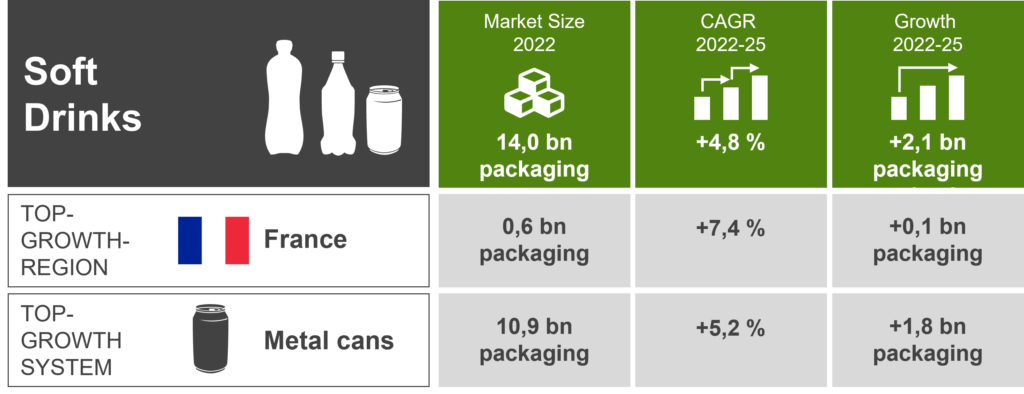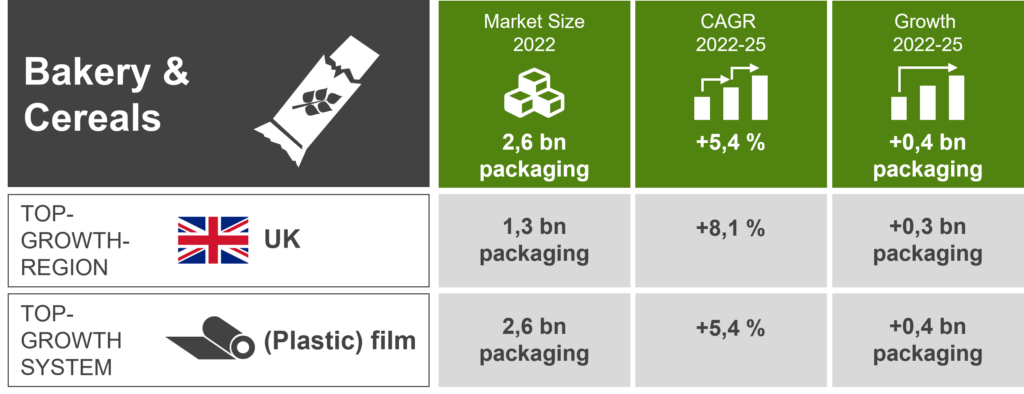Which markets and segments are growing? So where should the strategic view and industry orientation be directed? In the following article, we present the top 10 growth sectors for FMCG primary packaging in Europe for the period 2022-2025. In addition, we show you which country or which packaging system is driving the development. The analysis is the result of a B+P Consultants market analysis from Q2 2023 based on data from GlobalData – and a good starting point for your market strategy.
Background
For many companies in the packaging industry, long-term profitable growth is a major challenge, especially when it comes to acquiring new customers. One reason for the difficulties is the lack of orientation by industry. This applies to both strategic and organisational orientation. This shortcoming is currently proving to be particularly serious, as the markets are extremely disruptive and are being shaped by many trends at the same time.
In order to remedy this and to be able to work on and develop specific sectors in a targeted and successful manner, it is therefore necessary to have a deeper understanding of what moves the sector and what solutions are needed.
The Top 10
You will find the following data for each industry, market and driver (system or country):
- Relative growth (CAGR) of the respective market
- Total absolute growth (2022-2025)
- Market size of the FMCG industry
The sorting is ascending, i.e. the sectors with the fastest growth are at the end of the top 10.
#10 – Dried Pasta
The triumph of spaghetti and co. has a long history. And yet the French and Germans in particular can’t get enough of it. The packaging with the greatest growth is the folding box.

#9 – Take-Home and Bulk Ice Cream
The best ice cream parlour seems to be one’s own balcony or garden. At least, not only the greenery grows here, but also the consumption of ice cream. The cup (made of paper) is particularly popular as a “pot”.

#8 – Dishwashing Products
Wherever people eat, dirty dishes accumulate. France is particularly clean (or do they eat a lot there?). Plastic film is proving to be particularly strong in growth.

#7 – Dried Soup (Mixes)
Dry or instant soups are not considered the pinnacle of culinary art. But they have come to more attention in times of pandemic and energy crisis (because of the little electricity needed for a hot meal). The increasing consumption is mainly packaged in plastic (foils).

#6 – Ready Meals
Whether in Germany, Spain or Italy, whether in foil, trays or cups: ready meals are far from finished (cudos Giovanni Trapattoni). The fastest-growing packaging material is plastic.

#5 – Pizza
Pizza is always good. And it comes in every imaginable variety. Some are so creative that you hardly want to try them. Pizza fans are growing, especially in the UK. Here, too, plastic film is the dominant packaging material.

#4 – Rice
Rice cultivation has a 500-year tradition in Italy. The country is the number one rice producer in Europe, and around 60 percent is exported. Let’s see if it stays that way, because domestic consumption is growing rapidly. Strong growth as packaging: plastic film.

#3 – Functional Drinks
Functional drinks are non-alcoholic beverages that are intended to offer more than just taste and thirst quenching – for example, energy or vitamins. Most of the time, the drinks come in metal cans – and that will continue to be the case. More often than not, people in France in particular will treat themselves to the liquid boosters.

#2 – Cereal Bars
A quick thirst is followed by a quick hunger (or vice versa). What is called a “muesli bar” here (which sounds kind of healthy) is becoming (even) more popular, especially in the UK. Despite “paperization”, plastic film remains the packaging with the strongest growth.

#1 – Rice, Nut, Grain and Seed Based Drinks
May not call itself milk, but is often intended to replace it. Drinks based on rice, nuts, grains or seeds have long since left the microclimate of latte bars in trendy districts and are conquering the general population. The boom within the boom will take place in Spain, packaged mainly in beverage cartons.

Conclusion
Clearly, the opportunities for growth are there. You just have to know where and in what form. This is exactly what a good market strategy can provide – and thus become the key to successfully developing sectors.
The basis for the market strategy is a deeper understanding of what moves specific sectors and what solutions are needed there. On this basis, a targeted and efficient strategic and organisational alignment can take place.
If you want to develop a market strategy that clearly segments and prioritises your market by industry and derives from this an approach to the industry orientation of your company – then you can build on our expertise.

